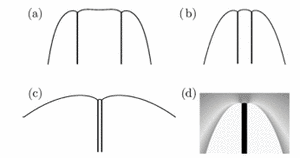Eutectic Solidification
We study the growth of a two-phase finger in eutectic systems, using a boundary-integral formulation. We complement our investigations by a phase-field validation of the stability of the patterns, which were observed experimentally by Akamatsu and Faivre. The deviations from the eutectic temperature and from the eutectic concentration provide two independent control parameters, leading to very different patterns depending on their relative importance.

Fig. 1: Tip of two-phase fingers during eutectic solidification, computed with Green's function methods and phase field models.
© Claas Hüter, Max-Planck-Institut für Eisenforschung GmbH
